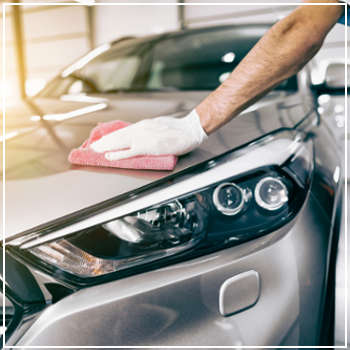 While doing a DIY paint touchup or waxing your car might seem like a quick and easy solution, it often doesn’t deliver the best results. When it comes to paint, you could end up with adhesion problems or an uneven, gritty texture if you’re not careful. Professional detailing services, such as waxing, ensure a higher quality finish and better protection against the elements, keeping your car looking its best for longer.
While doing a DIY paint touchup or waxing your car might seem like a quick and easy solution, it often doesn’t deliver the best results. When it comes to paint, you could end up with adhesion problems or an uneven, gritty texture if you’re not careful. Professional detailing services, such as waxing, ensure a higher quality finish and better protection against the elements, keeping your car looking its best for longer.
Why Wax Your Car and How Often?
Waxing is one of the most effective ways to preserve your car’s exterior. It creates a protective layer that shields your vehicle from harmful environmental factors like UV rays, tree sap, bird droppings, and road grime, while also helping to prevent rust. A good wax job also helps rainwater bead up and roll off the surface, which keeps your paint looking shiny and fresh. Without regular waxing, your car's paint can gradually lose its luster, becoming dull and faded over time.
As a general rule, it's recommended to wax your car every three to four months. However, this can vary depending on where you live and how often your car is exposed to harsh conditions. If you're in an area with extreme weather—whether very cold or hot—your car may experience more wear and tear than those in milder climates. In such cases, you might need to wax more frequently, especially if:
- Your car is driven on salted roads during the winter.
- You live in an area with high pollution levels.
- You park under trees regularly, exposing your car to sap and bird droppings.
- You leave your car outside daily, subjecting it to constant sun, rain, and wind.
It’s also a good idea to check your car’s exterior every 45 days to see if the wax is still holding up. The type of wax you use can affect how long it lasts—natural carnauba waxes tend to wear off faster, while synthetic options can last up to a full year. During a professional waxing session, your car will be thoroughly cleaned, including the wheels, door jambs, and window seals. After all dirt and debris are removed, the paint is polished, and then a high-quality wax and sealant are applied to protect the surface.
When to Get Your Car Professionally Waxed
Professional waxing offers a level of quality and thoroughness that’s hard to match with DIY methods. If you notice any of the following signs, it might be time to bring your car in for a professional service:
Your Car No Longer Passes the Bead Test
This simple test involves spraying water on your car’s surface. If the wax is still effective, the water should form distinct beads that roll off easily. But if the water spreads out into sheets or streaks, it’s a sign that the wax has worn away and needs to be reapplied.
You Spot Dry Paint
If you notice dry, cracked areas on your car’s paint, it’s a clear sign that the wax and clear coat are no longer providing adequate protection. At this stage, UV exposure may have damaged the paint, and moisture inside the paint can start to evaporate, leading to further damage.
You Hear a Squeaking Sound
A common way to test wax condition is by using a folded towel and rubbing it across the car’s surface. If you hear a squeaky sound, it means the wax has thinned out too much. A properly waxed car should feel smooth and allow the towel to glide without resistance, even when pressure is applied.
You Spot Scratches
Minor scratches can sometimes be hidden by wax, but if they become more visible, it’s a sign that the wax is wearing off and needs to be touched up or reapplied. Regular waxing helps maintain a uniform finish and reduces the appearance of small imperfections.
For top-notch detailing and long-lasting protection, trust DaSilva’s Auto Body to take care of your car. Whether you need a simple wax or a full exterior detail, our team is here to help. Contact our Naugatuck location today to schedule your appointment and keep your car looking its best all year round.
One of the main advantages of greenboards is their durability. The steel sheet base material is strong and long-lasting, while the green coating is resistant to scratches, stains, and other types of damage. This makes greenboards a good choice for high-traffic classrooms where the writing surface may be subject to frequent use.
Greenboards are also easy to clean. The non-porous surface can be wiped clean with a damp cloth or eraser, making it quick and easy to maintain. Additionally, the green color of the board provides a high contrast for writing with chalk or markers, making it easy to read from a distance.
Another advantage of greenboards is that they are less reflective than whiteboards, which can reduce glare and eye strain for students and teachers. The matte finish of the green coating also provides a more natural writing surface, which some people may prefer over the smooth, slippery surface of a whiteboard.
Overall, greenboards are a popular choice for schools due to their durability, ease of cleaning, and high contrast writing surface. While digital whiteboards and other high-tech tools have become more common in some schools, greenboards remain a reliable and effective teaching aid in many classrooms.
Greenboard Steel Coil,greenboard steel board,raw material for greenboard,ppgi greenboard for writing
Wuxi Shengshu Metal Co., Ltd. , https://www.wuxissmetal.com